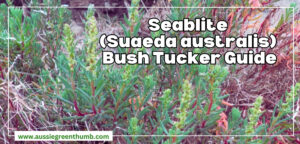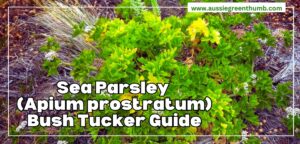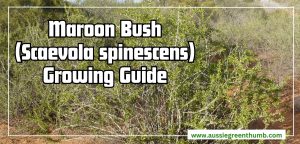Ylang ylang is the flower of the Cananga, a tree that grows rapidly in tropical climates and still performs well in temperate zones. It’s a pretty flower resembling a curling star and offsets its complementary green foliage with a dash of yellow – enough to light up the whole tree.
More...
Family: | Annonaceae |
|---|---|
Genus: | Cananga |
Species: | C. odorata |
Origin: | Southeast Asia, particularly in Indonesia, Malaysia, and the Philippines |
Common Names: | Ylang Ylang Tree, Perfume Tree |
Location: | Outdoor |
Type: | Tree |
Growth: | 10 to 15 metres tall and wide |
Sun requirements: | Full sun |
Foliage Colour: | Green |
Flower Colour: | Yellow |
Flowering: | Spring |
Maintenance level: | Low |
Poisonous for pets: | All parts of the plant are toxic to cats and dogs |
Introducing Ylang Ylang Tree
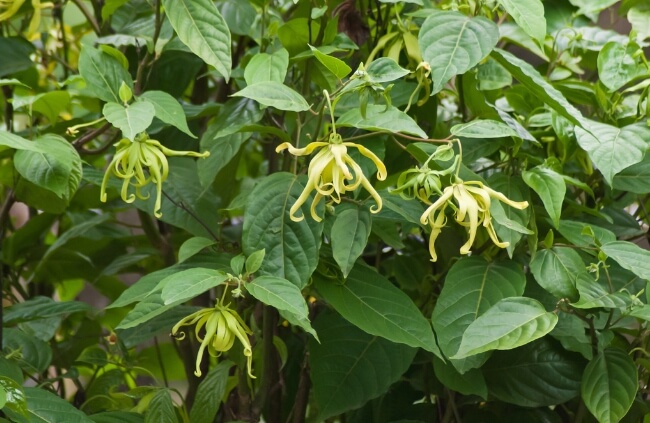
The striking and fragrant blooms of this tropical tree are prized for their essential oils which are commonly used natural materials in the perfume industry.
There’s a lot to love about this spectacular specimen so in this article, I will be explaining everything you need to know to grow and care for the Ylang Ylang tree in your garden, as well as highlight possible uses for its valuable essential oils.
Cananga odorata Plant Details
Part of the custard apple family Annonaceae, Ylang-Ylang is a fast-growing tree native to Southeast Asia and Australia and is botanically named Cananga odorata.
The tree thrives in warm and humid conditions, suited for our more tropical and subtropical regions. In ideal environments, the tree will typically reach about 10 to 15 metres tall and wide.
Should you not have the space for such a large tree, you can opt for its smaller relative, Desmos chinensis or the “Dwarf Ylang-Ylang”. This small but prolific relative grows to just 1 metre in height with powerfully scented flowers like its larger family member.
Landscaping Applications
The tree features gorgeous evergreen foliage and vivid flower displays throughout most of the year, making it a useful feature specimen in any garden that needs some more colour and interest.
Alternatively, this species can be trained to grow with a more spreading, shrubby habit, perfect for use as a decorative screen, or as gap-filling in larger spaces around the garden.
How to Grow the Ylang Ylang Tree
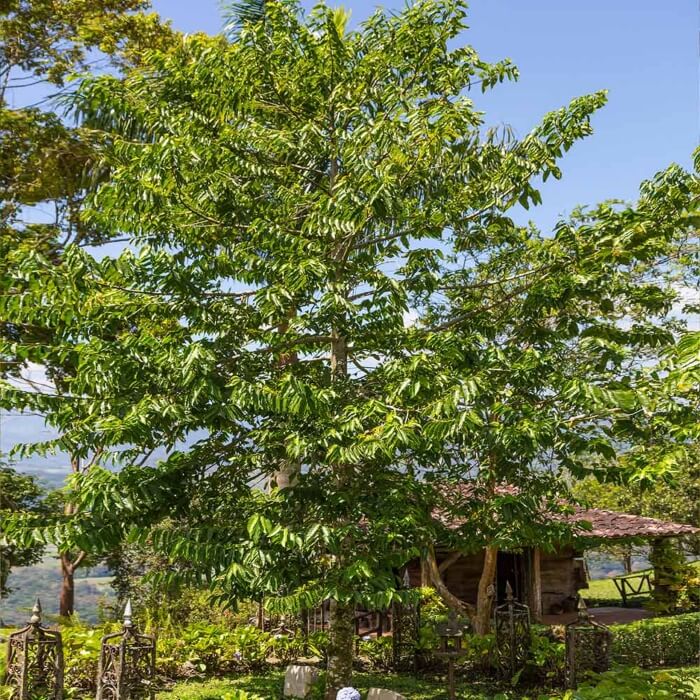
Source: Fast Growing Trees
Ylang Ylang Tree Propagation
The ylang ylang tree is best propagated using seeds or cuttings. Alternatively, young and healthy tubestock plants are available online that you can simply transplant into suitable conditions in your home or landscape.
This Australian native is endemic to tropical regions so be sure to establish the tree in warm and temperate environments.
Growing Ylang Ylang from Seed
- Collect healthy seeds from mature fruits that have yellowed or turned brown.
- Soak the seeds in some water for 24 hours before planting to increase the likelihood of germination.
- Prepare a seed tray or a small pot by filling it with a quality, well-draining potting mix or seed-raising mix.
- Sow each seed about 3 centimetres deep then water lightly.
- Place the seeds in a warm and sheltered location that gets healthy amounts of bright, indirect light.
- The ideal environment for germination should have mostly consistent temperatures of around 21°C to 27°C.
- Keep the soil moist but never waterlogged during germination.
- Germination can occur within 4 weeks to a couple of months depending on the growing conditions.
- You can then transplant seedlings into individual pots to further develop good roots and true leaves.
- Seedlings will still need bright, indirect light and regular water until ready for transplantation outdoors.
Propagating Ylang Ylang Using Cuttings
- During spring to early summer, take semi-hardwood cuttings from a healthy Ylang Ylang tree for propagation.
- Each cutting should be at least 15-20 centimetres in length with healthy leaves.
- Remove the lower section of the cuttings below the leaf nodes, ensuring there are still about 2-3 sets of leaves on each cutting.
- Remove the lower leaves from the cuttings then dip the cut ends into some rooting hormone.
- Prepare well-draining containers with quality, well-draining potting soil.
- Plant the cuttings into the mix by burying the lower section of the stem into the soil until firm.
- Water after planting then place the cuttings in a warm and humid location that receives indirect light.
- Water to keep the soil moist but never wet and mist regularly to assist with humidity.
- The cuttings should root within a few months. Allow the roots to properly develop before moving into a larger container or suitable outdoor location.
- Cuttings will need adequate light and water as they grow.
Planting and Growing Conditions for Cananga odorata
As mentioned, this tree is more suited to the warmer regions of Australia. While this species does not demand overly strict conditions to grow, ensuring it is planted and grown in the most ideal conditions possible will assist with overall plant vigour and better blooming periods.
Ideal Planting Location for Ylang Ylang
This species of rainforest tree thrives in full sun. Pick a spot in your garden that gets at least 6 to 8 hours of direct sunlight daily.
Preferred Soil, Temperature, and Humidity
This tree tends to prefer slightly acidic but well-draining soil. Aim for a soil pH level of between 6.0-7.0. It can also tolerate many different types of soil but prefers loamy and sandy soil rich in organic materials.


Get Your Free Guide:
Master Growing Australian Natives eBook
A Must Have Complete Guide for Every Australian Garden
Get Your Free Guide:
Master Growing Australian Natives eBook
A Must Have Complete Guide for Every Australian Garden
You can boost your soil by mixing in some compost or well-rotted manure before planting. Ideal temperatures for these trees are between 21°C to 32°C. They thrive in warm and humid conditions and need to be protected from frost and cold winds.
Water Needs
This species will appreciate regular water, especially while young. It is important to keep the soil consistently moist but never waterlogged. Water your tree deeply once the soil has dried to the touch.
Water more frequently in summer and less in winter. On average, the tree will need water every 2 to 3 weeks in good conditions.
Fertilising Ylang Ylang
You can add some organic fertiliser regularly during periods of growth to assist with flowering and healthy roots. Try to use a balanced, slow-release fertiliser.
When to Prune Ylang Ylang Trees
Prune your tree in early spring before new growth emerges to help maintain your desired shape and to promote bushier, denser growth and more flowers.
Ylang Ylang Essential Oils
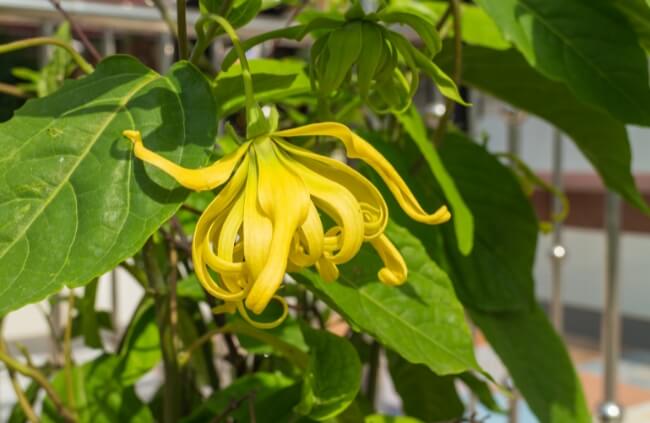
The flowers of ylang ylang aren’t admired for their beauty. Instead it’s their essential oils that give it a star quality and makes it revered around the world by perfume and oil purveyors. The scent is not too dissimilar to jasmine but it offers deeper, richer notes that comfort the senses and makes it ideal as a massage oil.
The only downside to ylang ylang massage oil is its price. Obviously an economical supply and demand issue, obtaining good quality oil is getting harder to achieve.
The Javan’s have begun production of Cananga oil, a far less superior alternative by using flowers from C. odorata var. macrophylla, as flower production from the much more perfumed C. odorata (Annonaceae) starts to dissipate.
For every 1 kg of flowers that the cananga tree produces 20 ml of ylang ylang oil is extracted and a mature tree only produces 10-15 kg of flowers per year – resulting in a mere 250 ml each year.
Second, third and fourth distillations can happen extracting more oil and these are referred to as Ylang Ylang 1, 2 and 3 respectively. The first “press” is known as ‘extra’ much like EVOO.
What Ylang Ylang Variety to Use?
So, if you wanted to start making your own ylang ylang massage oil at home, how would you go about it? First, it starts with a tree – and not just any old cananga. As previously mentioned, the best variety for subtleness of perfume and quality characteristics is Cananga odorata (Annonaceae).
This tree produces smaller flowers and reduced yields compared to the Indonesian species but is of a far greater quality. And, it grows quickly, maturing within 10 years or less.
Once your tree is producing enough flowers to make it worthwhile you can begin thinking about how you're going to extract the essential oils from them. The best known method is via steam distillation.
Extracting Ylang Ylang Essential Oil
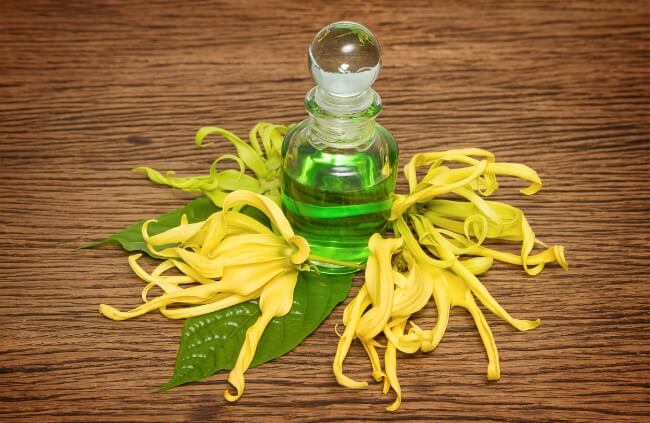
This process requires a steam distillation kit consisting of a few glass flasks, some rubber tubing, a method of heating (your gas stove may be adequate) and some plant material – namely your ylang ylang flowers.
The first vial contains water and sits on the stove or bunsen burner simmering away. The steam then passes into the second vial where the flowers are placed and it begins to “sweat” the flowers into giving up their essential oil.
The steam, mixed with the oils, then passes through a condenser tube effectively cooling the steam mixture until it begins to condensate. This process begins to turn the steam back to a liquid and the oils begin to solidify a little.
From there, the steam distillation process leads to the final point – where a separatory funnel is required. This final process separates the ylang ylang essential oil from the hydrosol (flower water) and gives you the final product.
This process can be used for a myriad of other plants including lavender, roses, jasmine and even some of your herbs.
Making Your Own Ylang Ylang Massage Oil
Once you have extracted the essential oils from the ylang ylang, massage oil creation is the final step.
The oil is a concentrated extract and needs to be mixed with other fat such as kukui nut oil, jojoba, almond oil or even Shea butter oil – which are often readily available at health & body shops. The ratio of mix is usually 6 teaspoons of “carrier oil” to 6 drops of essential oil.
Ylang Ylang Tree Frequently Asked Questions
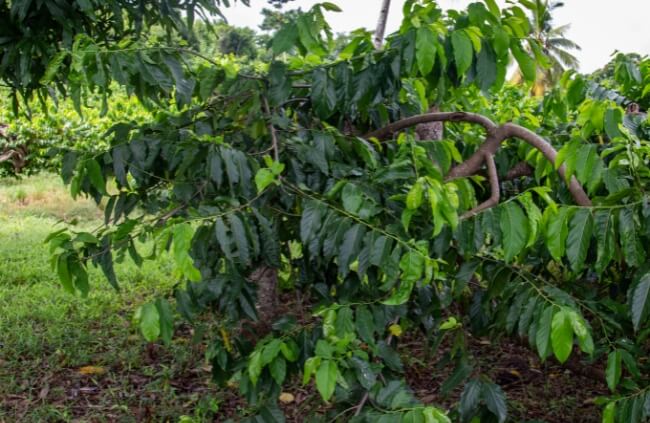
How fast does Ylang Ylang grow?
This species is considered fast-growing, especially in ideal conditions. It can grow up to 2 metres per year, perfect for those looking to establish a mature shade tree in their gardens for hot summer days.
What is the English name for the Ylang Ylang tree?
Another popular common name for the tree is the Perfume Tree, owing to its heavily scented flowers.
Is Ylang Ylang a tree or a shrub?
Cananga odorata is considered a medium-sized tree. It can add a shrubby appearance to gardens thanks to its pendulous branches that burst with drooping, leafy foliage and flowers.
Is Cananga odorata fruit edible?
While the ripe black fruits of the tree are quite edible, they are not commonly used in foods or as a bush tucker. The tree is noted for its valuable essential oils which are extracted from the flowers.
What are the medicinal uses of Ylang Ylang?
The essential oil (also known as ylang-ylang oil) is typically used in aromatherapy to treat anxiety, high blood pressure, headaches and even depression. The oils are also used for their intense floral scent to enhance perfumes.
What do Ylang Ylang flowers smell like?
The smell of Ylang-ylang is said to feature delicate floral notes with undertones of custard, banana, and jasmine.
Wrapping Our Ylang Ylang Growing Guide
Whether for its striking floral displays, its valuable essential oils, or its ability to add comforting shady silhouettes around the garden, the Ylang Ylang tree certainly has a lot to admire.
I hope this article gave you a good understanding of how to take advantage of this tree’s ornamental influence in your garden. Enjoy the ever-vigorous Ylang Ylang tree and start growing yours today.
Published on October 29, 2023 by Nathan Schwartz
Last Updated on September 20, 2024


